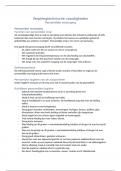Summary
Samenvatting PIM, Blok 3, S2, F&C
- Module
- Institution
Samenvatting om het tentamen van PIM in blok 3 van het tweede jaar van de opleiding F&C te behalen. Het bevat de hoofdstukken 1 t/m 3 uit het Diktaat en H9.1 uit het boek: Management Accounting: berekenen, beslissen en beheersen. Mocht je deze samenvatting hebben gekocht en pagina's zijn versprong...
[Show more]








